Christopher Cerf, the state-appointed superintendent of Newark Public Schools, smiled broadly as he arrived at Arts High School for a school advisory board meeting last March. He sprang out of a car driven by an aide, and waved to a clutch of protesters gathered in front of television cameras. On his way to the auditorium, he shook hands and offered hugs; once there, he scanned the crowd like a politician, looking for people with whom he needed to make a connection. He exchanged greetings with a group of students and former students who call themselves the Newark Student Union and frequently show up to protest. A megaphone was nearby.
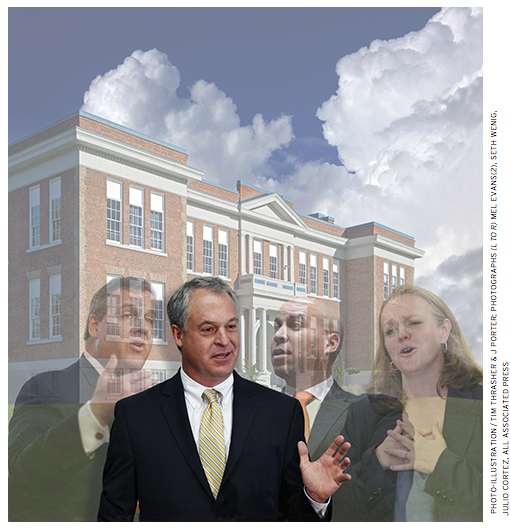
Cerf was not rattled when students began shouting “save our schools!” through the megaphone, or when they and others called him a liar, demanded his resignation, and declared that he only cared about students in charter schools. At one point during the four-and-a-half-hour meeting, he was accused of poisoning children. “If we can’t have what we want, we shut it down!” someone shouted.
The most immediate cause of the anger was new results from annual water-quality tests, which found elevated amounts of lead in 30 of Newark’s aging school buildings. But that latest outrage was layered on top of long-simmering frustration with the state of New Jersey, which has controlled the city’s schools and determined who is in charge of them for more than 20 years. In some ways, the sole purpose of the meeting was for members of the public to air their concerns: the Newark Public Schools Advisory Board is publicly elected but has only limited power under New Jersey’s state takeover law, making Cerf the only person in the auditorium with any real decision-making power.
That power also makes Cerf, like his predecessors, the person Newarkers can blame when things go wrong, as well as the face of state oppression. Cerf was appointed superintendent in July 2015 by New Jersey governor Chris Christie, and had previously served as his state commissioner of education. His tenure follows the controversial leadership of former superintendent Cami Anderson, who led a series of unpopular initiatives in quick succession, including a new citywide enrollment plan and lottery that allowed parents to choose any traditional or charter school in the city, closures of underenrolled or poorly performing schools, mass firings of teachers and principals, and a new merit-pay program for teachers.
The changes had some benefits for students, but many parents and teachers felt ignored and disrespected, and the relationship between Anderson and the public broke down. Protesters, bloggers, and other critics called her a bully who dismissed anyone who disagreed with her as a defender of a system that was failing far too many students. The Newark Public Schools Advisory Board passed a “no confidence” vote in her leadership. Public outcry became so impassioned and so personal that Anderson and her leadership team stopped attending advisory board meetings in February 2014, declaring that they would focus aggressively on implementing change rather than participate in forums they considered dysfunctional and “no longer focused on achieving educational outcomes for children.”
Months later, Anderson resigned and it was up to Christie to appoint a successor. In a move that seemed politically tone-deaf, if not outright hostile, Christie replaced her with her former boss: Cerf.
“More Reformy Than Ever”
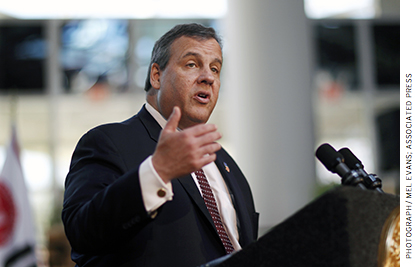
Cerf’s reputation and résumé did little to win fans in Newark—as commissioner, he had been deeply involved in reform efforts there and would be, as one blogger put it, “More Reformy Than Ever.” He had quit in 2014 for an executive post at Amplify, a company that provides data, curriculum, assessment, and professional development services to school districts and at the time was part of Rupert Murdoch’s News Corporation. When Cerf’s nomination by Christie was announced, critics seethed. When he was officially confirmed by the New Jersey Board of Education, John Abeigon, the president of the Newark Teachers Union, was thrown out for disrupting the meeting.
But Cerf was more experienced in education than skeptics allowed. Cerf, 60, started his career as a history teacher in Cincinnati, Ohio, a generation before top-achieving college students sought out teaching opportunities through Teach for America. Columbia University law school, clerkships in the U.S. Appellate and U.S. Supreme Courts, a stint in the Clinton White House, and private practice followed. He completed the Broad Academy for superintendents in 2004, and then spent five years as deputy chancellor of the New York City schools under then-Mayor Michael Bloomberg and schools chancellor Joel Klein.
From the start, Cerf understood that as superintendent he had to take a different approach from Anderson’s, and do all he could to smooth the political waters. That was evident in his first appearance at an advisory board meeting, in August 2015.
“I pledge to you a dialogue based on civility and respect and availability and facts and information,” he told the audience and board. Everyone is entitled to their opinion, he said, but “they’re not entitled to their own facts.”
“Our children are watching how we conduct ourselves,” he said. “We are providing a model for how civil civic discourse takes place, and how we do that even when we disagree is so critically important.”
Disagreement over the governance of Newark schools goes back more than two decades; the state took over the district in 1995 after documenting years of academic failure, unsafe buildings, corruption, and lavish spending by elected school board members. Board members had been given cars and gas allowances, and were allowed to eat on the district’s dime at numerous local restaurants. A report at the time noted that, as state officials were seizing files in the district offices, three board members were attending a conference in Hawaii. Meanwhile, just one in four Newark high school students passed state proficiency tests in reading and math.
For years, state-appointed superintendents came and went. Newark outspent virtually every school district in the country—it spent about $25,000 per student in 2013, for example—yet there was little change in outcomes for students, who mainly come from low-income families (Figure 1). Today, 79 percent of students receive free or reduced-price school meals. Some 47 percent of students are African American, 44 percent are Hispanic, and 8 percent are white.
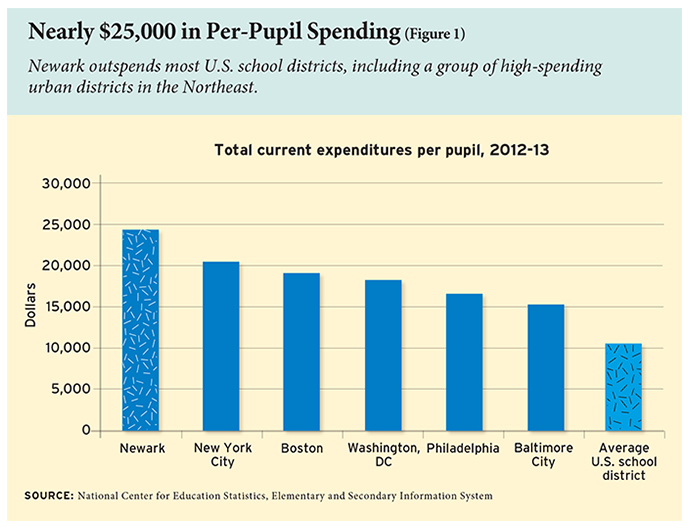
Soon after he was elected in 2009, Christie, a Republican, and then-Newark mayor Cory Booker, a Democrat who has since joined the U.S. Senate, agreed that something radical needed to be done. They vowed to join forces and make Newark a national model for how to improve urban education, and Booker went looking for money to make that vision a reality. Facebook founder Mark Zuckerberg had famously stepped up with a $100 million gift that was to be matched by others.
The gift in 2010 drew national attention to Newark from two opposing camps. On one side: the informal network of advocates, philanthropists, educators, and nonprofit organizations that all back higher academic standards, greater accountability, and improved teaching, and who saw the city as a potential proof point for their theories of how to improve student outcomes. On the other: the anti-charter school crowd, the American Federation of Teachers, and other critics who decry what they call corporate-style education reform, and who saw Newark as a place to draw the line and fight back.
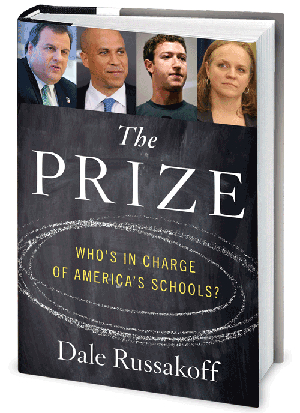
The contentious years ahead were the subject of a high-profile book by former Washington Post reporter Dale Russakoff, The Prize: Who’s in Charge of America’s Schools, which was published just as Cerf became superintendent. The book focuses on the difficulties in implementing change in Newark, despite bipartisan leadership, financial support, and the attention of education watchers nationwide. A major theme, according to Cerf, is a “narrative of failure” in Newark schools.
Changing that narrative is a critical challenge, he says, one helped by evidence of improvement in recent years. The suspension rate is down 37 percent. The graduation rate has risen to 70 percent from 61 percent in 2011. And about one in three Newark students attends “beating the odds” schools, those that outperform schools with similar demographics in their state in reading and math, according to a 2015 study by the Center on Reinventing Public Education.
Newark has retained 95 percent of teachers evaluated as “effective,” Cerf says, even though the district pays salaries lower than in surrounding towns. Only 63 percent of teachers who did not earn “effective” ratings remained in the district. The district also has invested heavily in new curricula in mathematics, science, history, and the arts. And more than half of Newark schools now have longer school days.
The premise of The Prize, Cerf says, was that if he, Anderson, and Booker had moved more slowly and worked harder to build local support for their ideas, they would have gotten a warmer reception. But, he says, that analysis is flawed.
“For Dale to criticize Cory and Cami for failing to have overcome political saboteurs, but give a complete pass to the saboteurs themselves, tells only part of the story. There was a vicious campaign of misinformation that was designed to thwart any changes.”
The Value of Listening
Cerf has set two major goals for Newark schools: to give every student in the city a chance to attend a successful school, and to meet state requirements that would allow the district to regain local control. Unlike Anderson, who was charged with using the Zuckerberg largess and the state’s backing to bring about the dramatic changes envisioned by Booker and Christie, Cerf views his job as making sure those changes take root, grow, and eventually bear fruit. Both jobs are difficult, and require different skills and temperaments. Anderson had to be bold and was under pressure to get quick results. Cerf has to build on and improve Anderson’s initiatives, while preaching patience and building and maintaining productive, long-term relationships with major constituencies in the city: families, the advisory board, the teachers union, and the mayor’s office.
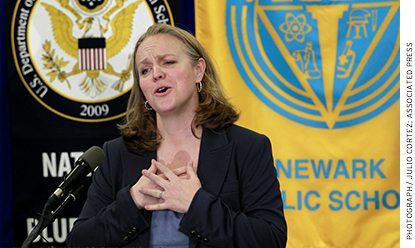
Since becoming superintendent, Cerf says, he has spent 80 percent of his time on “small-p politics” and has reached out even to “people who have been the loudest voices, people who have called me the devil to my face and said what we’ve done here is criminal.” He regularly seeks the advice of community groups, parents, teachers, and principals at closed-door meetings. “I ask them, ‘if you were in my chair, what would you do? What do you need? What stands in the way of you and academic performance?’” He has also convened a series of public meetings around the city to inform the district’s strategic plan.
Cerf says it’s a leadership style that has evolved over his time in education. He says that when he was younger, he believed that eliminating inequity required ignoring “the inevitable noise and objections and just throttle down, and do it, and wear a flak jacket and realize that people are going to say awful, ugly things about you,” and do all they can to get in the way.
Cerf says he still believes closing achievement gaps and improving student outcomes is urgent, and that the only way to do that is to make sure all decisions are made in the interests of students. But he says he has learned a lesson from the events in Newark and the growing pushback on education reformers nationally.
“I appreciate, in a way that I hadn’t before, that there is an essential value in listening and giving people an opportunity to seriously engage on important questions.” Still, as he often points out, “there is a difference between listening and agreeing.” He attends every advisory board meeting and does what he can to maintain civil discourse.
According to Booker, Newark politics have always been rough, and public frustration with 21 years of state control over city schools is understandable. Still, he says, the loudest and most antagonistic voices, those of the people who show up regularly to protest at city council and school advisory board meetings, are not necessarily representative of anyone but themselves.
“It’s a tribute to Chris that he doesn’t get upset by a lot of the tumult and is laser-like focused on improving student achievement,” Booker says.
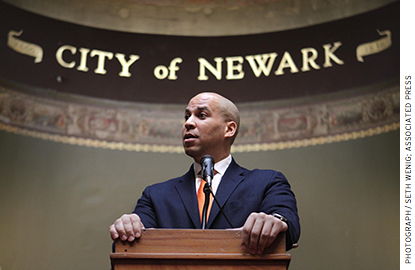
At the advisory board meeting in March, when Cerf was drowned out by a derisive roar of protests during the discussion of the lead results, he did not get upset.
“I can either tell you the facts or you can scream from the audience,” Cerf said, and waited while the disruptions continued, despite the meek attempts by the board chair to regain order. “I’m not going to [speak] until they shut up … that’s not the way democracy is conducted in this country,” he told the board chair evenly.
Eventually, he was able to proceed. There was plenty of information to share: Cerf had immediately insisted the lead test results be made public—something his predecessors had not done during the previous six years when similar results reached their desks—and arranged for drinking water to be delivered. He asked district staff to prepare a detailed report on the findings and the history of lead testing in the district, and began providing weekly updates on what was being done to address the issue. In the months to come, the district would test every source of water in every school in Newark; offer free, voluntary blood testing for all students; and hold regular public meetings to discuss families’ concerns.
Working with Local Leaders
Cerf has also forged collaborative relationships with local elected leaders.
Antoinette Baskerville-Richardson, a former theater and speech teacher, union official, and district administrator who now chairs the advisory board, said Cerf’s relationship with the board is evolving. She credits him with providing members with more extensive and timely information than his predecessor. She also noted that Cerf gave the board permission to call itself the Newark Board of Education—a symbolic gesture to drop the “advisory” label, which was appreciated by board members—and allowed it to vote on district expenditures before they are made, although he still has the final say.
“He smiles a lot, he’s cordial, he’s much more palatable than Cami Anderson,” Baskerville-Richardson says. “On the other hand, he has also exposed a part of himself, via his willingness to talk and engage, that is very combative, edgy, and sometimes disrespectful.”
Cerf has also collaborated with Booker’s successor, Mayor Ras Baraka, a former city councilman and high school principal whose 2014 campaign was based on his opposition to Anderson and her reforms and had the backing of the Newark Teachers Union. Last year, Cerf, Baraka, and other city leaders announced a $12.5 million plan to improve academics and provide social supports to a handful of schools in the South Ward, the poorest section of Newark. The South Ward Community Schools Initiative includes $10 million for school improvement and $2.5 million for dropout prevention services, and is to be funded in part by the Foundation for Newark’s Future—the organization that managed the Zuckerberg gift and matching funds, which are now exhausted. (The organization officially ceased operations at the end of April with $5 million left unspent; any remaining funds were to be held and dispersed by the Community Foundation of New Jersey.)
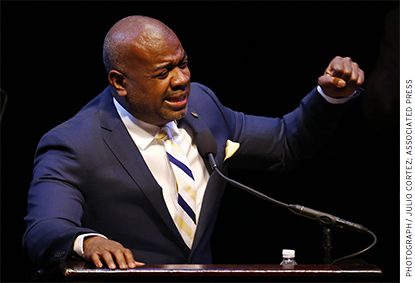
Baraka and Cerf, with Christie’s support, also are leading an effort to end state control in Newark schools. Districts under state control can earn back local authority by consistently demonstrating to state monitors sound policies and procedures and overall effectiveness. A nine-member Newark Educational Success Board, whose members include parents, students, and business and community leaders appointed by the mayor and governor, has been tasked with developing a plan that will restore local control as soon as possible.
Success board member Donald Katz, who is chief executive of Newark-based Audible, Inc., the audiobook and podcast company, praised the board’s work and credited Cerf with hastening the district’s progress toward independence. “What he has done is make around-the-clock efforts to create meetings of the minds among people who had hardened into certain viewpoints,” Katz says. “People have no idea how hard he works and all that he does to make sure all of the stakeholders who should be at the table are there.”
In March, Baraka praised Cerf in an annual state-of-the-city speech. “We’re not in a perfect place, but we have a new superintendent now … and a very contentious and raucous environment was turned into a plan, after 20 years, to clearly define a path toward local control for our schools,” he said. “Our job is not to just complain about the problems we have but to actually fix them.”
Still, there are some built-in tensions that Cerf has not been able to soothe, such as his relationship with the Newark Teachers Union. On one hand, he speaks with the union president, Abeigon, about once a month; the union had refused to speak with Anderson for more than two years. On the other hand, Abeigon has declined to negotiate a new contract for Newark teachers; the last contract expired in 2014. Instead, he is waiting until Christie’s term as governor ends in 2018.
The Charter Factor
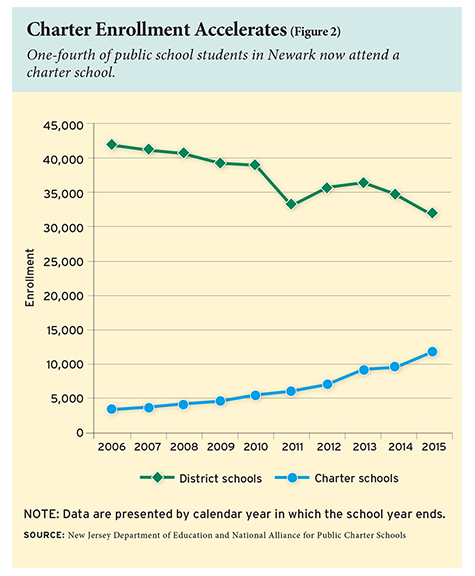 Another source of strife is intense disagreement over the role of charter schools in the district. One-quarter of Newark’s 47,000 students now attend a total of 43 charter school campuses; when all of the charter schools authorized by the state open, they will serve up to half of the city’s students (Figure 2). While they are supported by many families, charter schools face frequent public criticism—including by Baraka—that they are destroying the school district.
Another source of strife is intense disagreement over the role of charter schools in the district. One-quarter of Newark’s 47,000 students now attend a total of 43 charter school campuses; when all of the charter schools authorized by the state open, they will serve up to half of the city’s students (Figure 2). While they are supported by many families, charter schools face frequent public criticism—including by Baraka—that they are destroying the school district.
Cerf, an appointee of a pro-charter governor, is often labeled as a charter school advocate. He says he is less interested in how schools are governed than he is in making sure there are good schools in every neighborhood. “The point is that this is a part of a coherent change theory that is starting to bear fruit,” he says. “It’s not that we’re going to support charter schools and not traditional schools, we’re not ‘all in’ on charters, like in New Orleans. But, rather, we want to holistically manage a system of all different types of schools.”
The number of charter schools has quintupled over the past four years, which has cut into the district’s overall revenues. Payments to charter schools have grown from $117 million to an estimated $226 million of the district’s total budget, estimated at $990 million this year. To be sure, Newark’s per-pupil spending remains high compared to other districts in New Jersey and nationwide. But with fixed costs and declines in state aid in recent years, Newark has struggled to cut spending fast enough to offset the loss of revenue.
“One of the reasons emotions are running so high is that our children are the casualties of this war called school reform,” says Deborah Smith-Gregory, the president of the Newark chapter of the NAACP. “The charter schools continually get more money and the traditional schools get less.”
Under state law, charter schools are supposed to receive 90 percent of a school district’s per-pupil tax levy, and, unlike traditional public schools, must pay all of their building costs out of that amount. However, in practice, a complex state funding mechanism means charters may get slightly more, or substantially less, than neighborhood schools, based on their enrollment. Charter advocates claim the schools receive 70 percent of what traditional public schools in New Jersey receive, on average, while charter critics note that many outspend traditional public schools.
Regardless, many parents in Newark perceive charter schools as superior. Last year, 42 percent of parents who used Newark’s centralized enrollment system listed a charter school as their first choice. A 2015 study by Stanford University’s Center for Research on Education Outcomes (CREDO) found Newark charter schools outperformed traditional district schools: 77 percent of Newark’s charters were more effective at raising test scores in reading, and 69 percent were more effective at raising scores in math.
Nijn Wagstaff, a state worker who dropped out of a traditional Newark high school before returning to school to earn bachelor’s and master’s degrees, has sent two of her three children to charter schools. “I find myself many times defending my stance on charter schools versus traditional public schools,” she says. “As soon as I say charter schools are public schools, eyebrows are raised and the snarls come out and they say, ‘why aren’t you sending your son to a public school?’”
She says that her oldest son struggled academically and barely graduated from Newark’s Weequahic High School, a large comprehensive high school. Since high school, he has struggled “to find stable employment and find his place in society,” she says. Her second son graduated from a high school operated by KIPP New Jersey, which operates eight charter schools in Newark. He went to community college and is a manager at Sprint while finishing up business courses.
Her youngest son has only attended KIPP schools. “The teachers there truly, truly set the bar very high as to how children are supposed to be treated academically and nurtured all around,” she says. “Everybody is so helpful and loving, and they try to do anything they can to help you and the children.”
A Focus on Common Ground
There are some signs that the battle over charter schools may be dying down.
For example, earlier this year Mayor Baraka, the Newark City Council, school board members, the leaders of many charter organizations, education-related nonprofit groups, the Newark City Council, and several local and state representatives all signed a letter asking Christie to provide additional state aid. The letter noted that the district had already cut $150 million in costs and laid off 900 employees in recent years. More cuts, the letter said, would be devastating.
“We acknowledge that there have been issues related to our schools that have divided us in the past,” the letter said. “And disagreements over complex policy issues remain the subject of spirited, although increasingly civil, debate. We are united, however, around the central value of assuring that every one of our city’s children has access to a free quality public education.” The letter persuaded Christie to allocate an additional $27 million for the district and charter schools.
Another sign that factionalism in the city may be easing came in the April school advisory board election. Voters chose three candidates who proclaimed themselves part of a “unity” slate. One of the candidates was loyal to the mayor; another was aligned with a longtime political leader in the city’s North Ward; and the third was supported by a local pro-charter parent organization called the Parent Coalition for Excellent Education.
“Rather than focusing on differences, a community chose to rise together to address issues that unite us all,” Muhammad Akil, the group’s executive director, told a local newspaper. He called the results a turning point that demonstrated the political power of charter school backers as well as others who are seeking more high-quality learning opportunities for local students.
In addition, most of the charter schools in Newark signed a “compact” committing themselves to ensuring that “every child in Newark is enrolled in a great school, regardless of whether it is operated by the district or under a charter.” They also agreed to make it easier for parents to enroll their children in charter schools, and promised to make public more information about their track records.
Ryan Hill, the executive director of KIPP New Jersey, says Cerf has done “an amazing job of listening before acting. He’s shown he really cares what people think about this work and what they believe needs to be done. He’s helped Newark heal.”
Richard Lee Colvin, a longtime education journalist, currently manages the writing team at the U.S. Department of Education. He wrote this article prior to joining the department.
This article appeared in the Fall 2016 issue of Education Next. Suggested citation format:
Colvin, R.L. (2016). Continuing Change in Newark: To protect reform, Chris Cerf builds collaborative relationships. Education Next, 16(4), 36-43.


